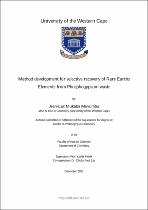| dc.contributor.advisor | Petrik, Leslie | |
| dc.contributor.author | Muvumbu, Jean-Luc Mukaba | |
| dc.date.accessioned | 2022-03-15T12:33:37Z | |
| dc.date.issued | 2021 | |
| dc.identifier.uri | http://hdl.handle.net/11394/8897 | |
| dc.description | Philosophiae Doctor - PhD | en_US |
| dc.description.abstract | The need for rare earth elements (REEs) in current technologies has motivated countries with high imports dependency to search for alternatives sources. Several studies have been carried out to investigate the feasibility for REE extraction and recovery through the recycling of low value waste streams. Amongst these waste streams, phosphogypsum (PG) which is a major by-product from phosphoric acid processing has drawn research attention as it contains up to an average of 0.4 wt % of REEs. To date, a number of approaches have been reported on REE extraction from PG leaches after a total or partial dissolution. Amongst all the approaches, adsorption was found as one of the most promising due to its high efficiency, availability and simplicity. | en_US |
| dc.language.iso | en | en_US |
| dc.publisher | University of Western Cape | en_US |
| dc.subject | Acid leaching | en_US |
| dc.subject | Adsorption | en_US |
| dc.subject | Nanofibers | en_US |
| dc.subject | Phosphogypsum waste | en_US |
| dc.subject | Rare Earths elements | en_US |
| dc.title | Method development for selective recovery of rare earths elements from phosphogypsum waste | en_US |
| dc.rights.holder | University of Western Cape | en_US |
| dc.description.embargo | 2023 | |

